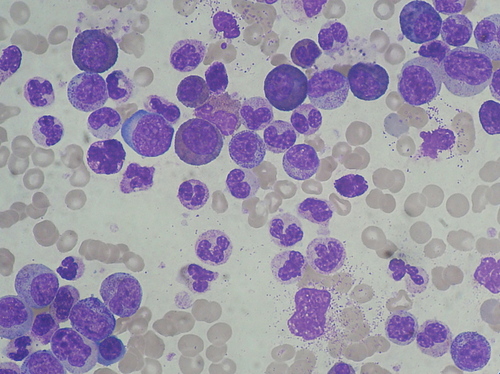Study: Cannabinoids Induce Incomplete Maturation of Cultured Human Leukemia Cells

Abstract
Monocyte maturation markers were induced in cultured human myeloblastic ML-2 leukemia cells after treatment for 1-6 days with 0.03-30 microM delta 9-tetrahydrocannabinol (THC), the major psychoactive component of marijuana. After a 2-day or longer treatment, 2- to 5-fold increases were found in the percentages of cells exhibiting reactivity with either the murine OKM1 monoclonal antibody or the Leu-M5 monoclonal antibody, staining positively for nonspecific esterase activity, and displaying a promonocyte morphology. The increases in these differentiation markers after treatment with 0.03-1 microM THC were dose dependent. At this dose range, THC did not cause an inhibition of cell growth. The THC-induced cell maturation was also characterized by specific changes in the patterns of newly synthesized proteins. Pronounced among these changes was an increase in the synthesis of at least 10 proteins that are found abundantly in monocytes. The THC-induced differentiation did not, however, result in cells with a highly developed mature monocyte phenotype; the THC-treated cells failed to exhibit other monocyte markers such as attachment to the surface of tissue culture dishes or morphological maturation beyond the promonocyte stage. However, treatment of these “incompletely” matured cells with either phorbol 12-myristate 13-acetate or 1 alpha,25-dihydroxycholecalciferol, which are inducers of differentiation in myeloid leukemia cells (including ML-2 cells), produced cells with a mature monocyte morphology. Two other cannabinoids, cannabidiol and cannabinol, which were more cytotoxic than THC at comparable doses, also caused an increase in the expression of maturation markers, but at doses higher than those required for THC. The ML-2 cell system described here may be a useful tool for deciphering critical biochemical events that lead to the cannabinoid-induced “incomplete” cell differentiation of ML-2 cells and other related cell types. Findings obtained from this system may have important implications for studies of cannabinoid effects on normal human bone-marrow progenitor cells.
Source: NIH Website

No Comment